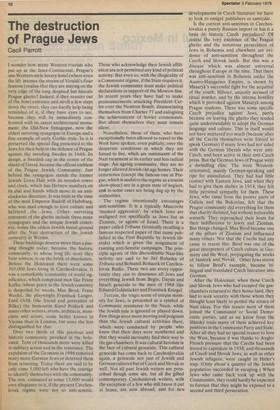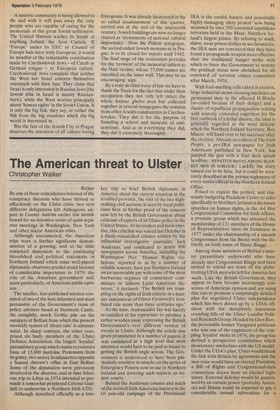The destruction of Prague Jews
Cecil Parrott
I wonder how many Western tourists who put up at the Inter-Continental, Prague's one Western-style luxury hotel (where even the lift intones the strains of Vivaldi's Four Seasons) realise that they are staying on the very edge of the long despised but historic Prague ghetto? Indeed, if they saunter out of the hotel entrance and stroll a few steps down the street, they can hardly help being reminded of it, if they have eyes to see, because they will be immediately confronted with its rarest architectural monument: the Old-New Syn,agogue, now the oldest surviving synagogue in Europe and a fine example of early Gothic style. In it is preserved the special flag presented to the Jews for their help in the defence of Prague against the invading Swedes in 1648. Its design, a Swedish cap in the centre of the shield of David, became the official emblem of the Prague Jewish Community. Just behind the synagogue stands the former Jewish Town Hall with its wooden tower and clock, which has Hebrew numbers on its dial and hands which move in an anticlockwise direction. It was built in the time of the mad Emperor Rudolf of Habsburg, who was mad enough to love culture and befriend the Jews. Other surviving remnants of the ghetto include three more synagogues and the unique Jewish cemetery, today the oldest Jewish burial ground after the Nazi destruction of the Jewish cemetery at Worms.
These buildings deserve more than a passing thought today, because the historic community, to whose long life story they bear witness, is on the brink of dissolution. Before the Holocaust there were some 365,000 Jews living in Czechoslovakia. It was a remarkable community of world significance, which comprised men like Franz Kafka, whose grave in the Jewish cemetery is despoiled by weeds, Max Brod, Franz Werfel, the playwright Frantisek Langer, Emil Orlik (the friend and portraitist of Rilke) the humourist Karel Polacek and many other writers, artists, architects, musicians and actors, some better known in Vienna than in London, but none the less distinguished for that.
Over two thirds of this precious and historic community perished in the holocaust. Tens of thousands more were killed in military action and in the resistance. The expulsion of the Germans in 1946 removed many more German Jews or deterred them from returning. Today there are said to be only some 5,000 left who have the courage to identify themselves with the community. The rest, estimated at some 15,000 would own allegiance to it, if the present Czechoslovak regime were not so anti-semitic. Those who acknowledge their Jewish affiliation are not permitted any kind of political activity. But even so, with the illogicality of a Communist regime, if the State requires it, the Jewish community must make political declarations in support of the Moscow line. In recent years they have had to make pronouncements attacking President Carter over the Neutron Bomb, disassociating themselves from Charter 77 and eulogising the achievements of Soviet cosmonauts. But about themselves they must remain silent.
Nonetheless, those of them, who have exceptionally been allowed to travel to the West have spoken, even publicly, over the desperate conditions in which they are forced to live, which are reminiscent of the Nazi treatment at its earlier and less radical stage. An ageing community, they are no longer allowed Jewish old-age homes. Their cemeteries (except the famous one at Prague, which is useful to the regime as a tourist show-piece) are in a gross state of neglect, and in some cases are being dug up by the authorities.
The regime intentionally encourages anti-semitism. It is a typically Muscovite 'masked aggression', by which Jews are maligned not specifically as Jews but as Zionists, or agents of Israel. There is a paper called Tribuna (ironically recalling a famous respected paper of that name published in the First Republic by Jewish liberals) which is given the assignment of running anti-Semitic campaigns. The principle agents of this discreditable Nazi-like activity are said to be Jiri Bohatka of Tribuna and Bohumil Rohacek of Czechoslovak Radio. These two use every opportunity they can to denounce all Jews and everything Jewish from Begin, Dayan and Israeli generals to the men of 1968 like Eduard Goldstiicker and Frantisek Kriegel.
Terezin, the tragic scene of unique memory for Jews, is presented as a symbol of Communist resistance to the Nazis, while the Jewish role is ignored or played down. Few things were more moving and poignant than the Jewish cultural activities there, which were conducted by people who knew that their days were numbered and that they would inevitably find their way to the gas-chambers. It was cultural heroism in the face of cultural genocide. This cultural genocide has come back to Czechoslovakia again, a genocide not just of Jewish and German cultures but of Czech and Slovak as well. Not all past Jewish writers are proscribed though some are, but all the gifted contemporary Czechoslovak writers, with the exception of a few who still brave it out at home, are now abroad; and for new developments in Czech literature we have to look to emigre publishers or samizdat.
Is the current anti-semitism in Czechoslovakia a purely Russian import or has it a basis in historic Czech prejudices? Of course the very existence of the Prague ghetto and the notorious persecution of Jews in Bohemia and elsewhere are evidence of anti-semitism throughout the Czech and Slovak lands. But this was a disease which was almost universal throughout Europe at the time. That there was anti-semitism in Bohemia under the Austro-Hungarian Empire, is shown by Masaryk's successful fight for the acquittal of the youth, Hilsner, unjustly accused of ritual murder, and by the intense hostility which it provoked against Masaryk among Prague students. There was some specific Czech prejudice against Jews, partly because on leaving the ghetto they tended quite understandably to adopt the German language and culture. This in itself would not have mattered too much (because after all the Czechs themselves were forced to speak German) if many Jews had not sided with the German liberals who were antiCzech, and been active in their anti-Czech press. But the German Jews of Prague were a dwindling elite. The were Westernorientated, mainly German-speaking and ripe for assimilation. They had had little contact with Eastern Jews, and when they had to give them shelter in 1914, they felt little personal sympathy for them. These Jews, who came from the poorer parts of Galicia and the Bukovina, felt that the Prague community did everything for them that charity dictated, but without noticeable warmth. They reproached their hosts for their indifference to Jewry and Zionism. But things changed. Max Brod became one of the pillars of Zionism and influenced many others. Not that the Czechs had any cause to resent this: Brod was one of the great interpreters of Czech culture in Germany and the West, propagating the works of Janacek and Novak. Other Jews strove to follow Brod's example, became bilingual and translated Czech literature into German.
After the Holocaust, when those Czech and Slovak Jews who had escaped the gaschambers returned to their home-land, they had to seek security with those whom they thought least likely to permit the return of Nazi ideas. For this reason most of them joined the Communist or Social Democratic parties, and as we know from the Slanskji trials many of them achieved key positions in the Communist Party and State. After all they had no special reason to love the West, because it was thanks to AngloFrench pressure that the Czechs had been forced to capitulate in 1938, and thousands of Czech and Slovak Jews, as well as other Jewish refugees, were caught in Hitler's trap. (Only about a quarter of the Jewish population succeeded in escaping.) When Jews who came back took up with the Communists, they could hardly be expected to foresee that they might be exposed to a second and third persecution. A historic community is being allowed to die and with it will pass away the only people who are capable of caring for the memorials of this great Jewish settlement. The United Nations washes its hands of anything behind the Iron Curtain. If 'Europe' under its EEC or Council of Europe hats were truly European, it would be mindful of the remarkable contribution made by Czechoslovak Jews — of Czech or German tongue — to European culture. Czechoslovak Jews complain that neither the West nor Israel concern themselves overmuch with their fate. They claim that Israel is only interested in Russian Jews (the Jewish elite in Israel is mainly Russianborn), while the West worries principally about 'human rights' in the Soviet Union. It is only the big fish, they say, or rather the fish from the big countries which the big world is interested in.
But the fate of the Jewish City in Prague deserves the attention of all culture-loving Europeans. It was already desecrated in the so called assainissement of this quarter, carried out at the end of the nineteenth century. Jewish buildings are now no longer classed as 'monuments of national cultural importance'. Now the Pink& synagogue, the second oldest Jewish monument in Prague, is to be closed for repairs until 1982. The final stage of the restoration provides for the 'revision' of the memorial tablets to the Nazi victims, whose 77,000 names are inscribed on the inner wall. This may be an encouraging sign.
By a truly devilish irony of fate we have to thank the Nazis for the fact that under their occupation they not only left intact the whole former ghetto area but collected together in several synagogues the remains from other Jewish communities in Czechoslovakia. They did it for the purpose of founding a school and museum of antisemitism. And as in everything they did, they did it extremely thoroughly.



































 Previous page
Previous page